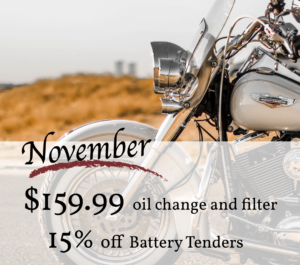Avoid Costly Repairs by Winterizing Your Bike Properly Now
Every spring, we have a stream of dozens of riders needing service before they can ever take that first spring ride. While we’re happy to help, we’d really love if everyone could avoid costly repairs that could have easily been prevented come spring time.
Here in the Midwest, transitioning from autumn riding to winter storage is the best way to keep your bike in riding condition. We’ve all experienced those random sunny days in December, January or February when you want to have the wind in your face. Follow these simple steps to be ready and prevent problems that would delay riding coming spring 2022.
How to Winterize Your Motorcycle
Prevent Rust & Corrosion with Lube
Protect any and all parts prone to rust or corrosion by applying lubrication. This includes your chain, bolts, cables and switches.
Change the Oil
There’s a reason we have an oil change special in November! Changing your bike’s oil before storing for winter is vital since used oil has contaminants (from doing its job). Contaminants that are suspended in the oil may gunk up and leave dirt in small cavities of the engine and hydraulic passages. Yes, you’ll want to start your bike once in a while to lubricate the engine again, but avoid running it for too long and causing contamination of the oil again.
Top Her Off
Fill up and top-off your gas tank before you roll into the garage. An empty gas tank tends to form condensation. We also recommend gas conditioner. Gas conditioner can protect your fuel for up to two full years. We recommend Helix 5 in 1. Today’s fuel turns bad after eleven days because of the alcohal content in the fuel.
Tickle with a Trickle
Keep your battery happy by putting it on a tender with a trickle charge over the winter months to keep it from draining. This extends the life of your battery since every time a battery dies, it loses some of its lifespan. Tenders also switch to float automatically to maintain the charge without overdoing it.
Shake the Shimmy
If your tires sit in one spot for a longer period of time, they may get flat spots causing a shimmy come spring that wasn’t present when you put it away. The easiest way to avoid this is to put your bike up on stands or a lift. If you don’t have a stand or want to spend money on a lift, here are a couple of things to do to save your tires:
- Move your bike around a couple of times a month to keep the tires from resting on the same spots.
- Add about 5PSI to each tire, as they naturally lose air over time.
- Park on plywood to help your tires avoid obtaining moisture from concrete floors.
By winterizing your bike using this checklist, you can avoid a number of preventable problems like batteries that don’t hold charge, dirty carburetors, clogged fuel injectors, and no-start issues from tarnished gasoline and tires that are out of balance or without the proper inflation.
Schedule your oil change today and get your bike ready for winter!
If you do find yourself out and about this winter, rest assured we’ve got your back with free towing within 60 miles November through February.


